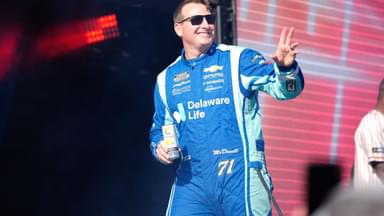Pit stop times in NASCAR have reduced a lot over the decades, from around 40 seconds in the 1960s to 8.5 seconds in recent seasons. This change is mainly attributed to technological advancements, better equipment, and crew training.
Advertisement
The improvement has also made the competition more cutthroat and forced drivers to perform better. Kyle Busch recently explained this on Door, Bumper, Clear.
The two-time champion said that beating drivers on the pit road was as crucial as beating them on the race track since the crews have become so much more efficient than they used to be. In his words, “Passing people on the racetrack is one thing. That’s hard to do. And now, you’ve got these pit crews that are blasting eight-second pit stops all the time. So, your roll time on pit road is imperative.”
He noted how his roll time on pit road can be matched by none over the past five years. However, the penalties that he has incurred at the same time have nullified the good work, and he wasn’t shy to admit that. His words point to the fact that the pit road presents a paradox. And yet, it’s arguably a better spot to gain positions than the race track is.
But it comes with risky challenges that could end days in the blink of an eye. The pit stop times of drivers are really close to each other now. This leads to them piling up as they attempt to gain the slightest advantage over the other. This is one of the major reasons for a lot of the aggressive contacts that are made on pit road. Nobody wants to give up space to the other.
NASCAR stars talk about the pressure on the pit road
The pit road at the Worldwide Technology Raceway is 22 feet wide and the narrowest in the NASCAR Cup Series. The Indianapolis Motor Speedway sits second with a pit road that is 24 feet wide. It is rather easy to see why trouble would arise when NASCAR’s Next Gen cars go in and out of these narrow roads as quickly as they possibly can.
William Byron said earlier this year, “I think you’re just seeing a lot of aggression because the pit stops are so fast and everyone is getting kind of cleared into — like you can have a decent or a slow stop and you might lose three or four spots because everyone’s in a really close pile.”
Michael McDowell has been around for a longer time than Byron has, and he holds a similar opinion. He said, “You just don’t give an inch because you don’t want to lose one spot, and that’s why you see more of the action on pit road. Because once they drop the jack, you’ve got to go. It doesn’t matter if a car is coming in or not, you’ve got to go, and nobody’s willing to give.”
It can be understood that drivers are willing to risk it all on the pit road and push to gain positions, all because their crews are able to do a stellar job of fixing up their cars with all the efficiency in the world.








